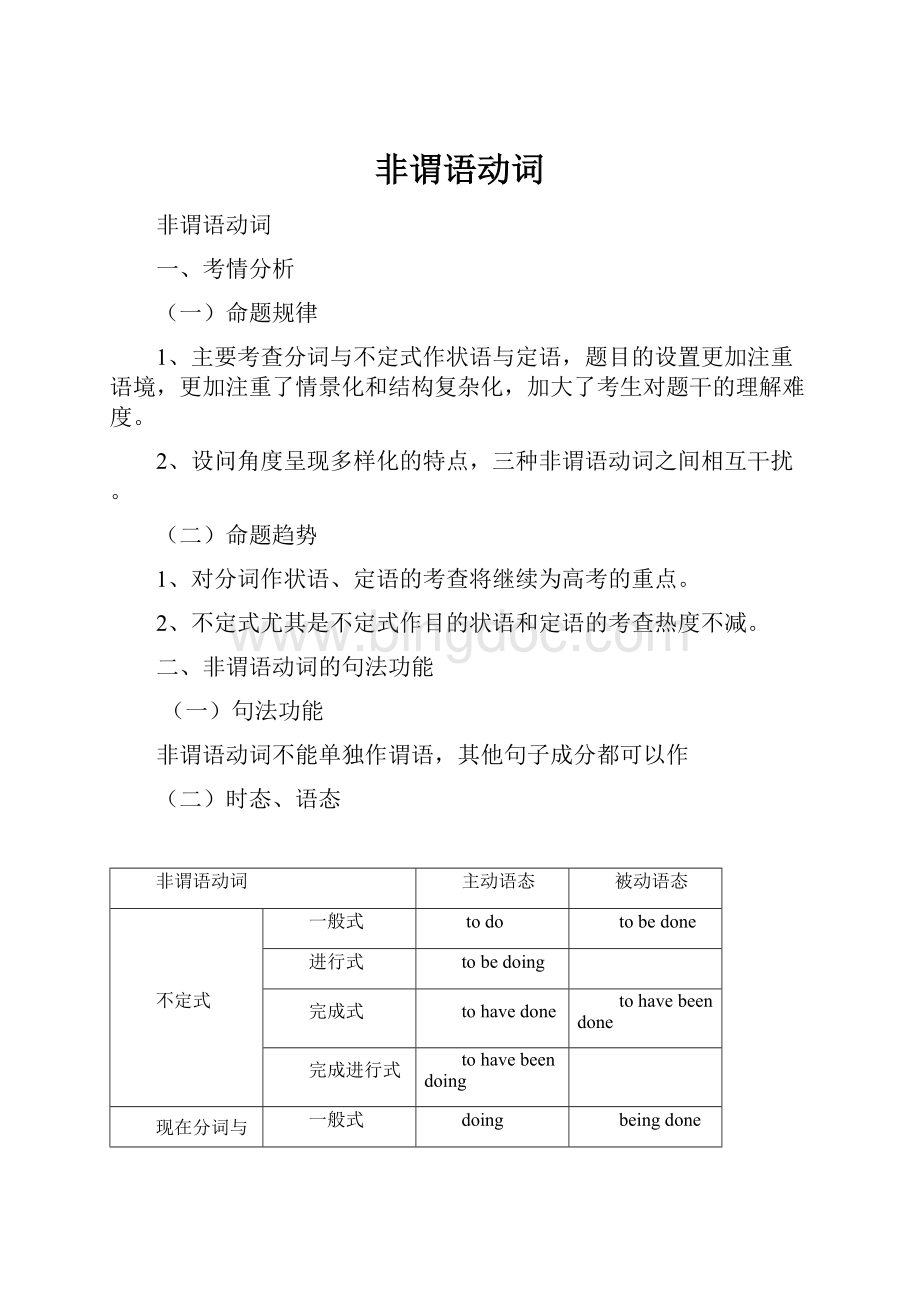非谓语动词文档格式.docx
《非谓语动词文档格式.docx》由会员分享,可在线阅读,更多相关《非谓语动词文档格式.docx(19页珍藏版)》请在冰点文库上搜索。

beingdone
havingdone
havingbeendone
注意:
1、动名词的复合结构就是在动名词前面加上它的逻辑主语。
其形式为:
名词所有格、普通格、代词宾格、形容词性、物主代词+动名词
Hisnotcomingtomybirthdaypartymademealittleanxious.
IrememberJane’s/Janegoingthere.
2、过去分词本身表被动完成,所以没有主、被动之分。
3、非谓语动词的否定式是在其前面加not.
三、非谓语动词作状语
(一)不定式作状语
1、目的状语
动词不定式作状语表目的,其逻辑主语亦是全句的主语,在强调这种目的状语时,不定式前面可以加inorder或soas,亦可把todo或inorderto放于句首,但soasto不能放在句首。
Istaredearlyto/soasto/inorderto(get)thereontime.
=To/Inorderto……
2、结果状语
不定式作结果状语,其逻辑主语通常也是全句的主语。
常在so/such…asto,enoughto…,onlyto…,以及too…to等结构中表结果。
Hehurriedtothestationonlyto(find)thetrainhadalreadyleft.
3、原因状语
不定式作原因状语,往往用在表示情感或态度的形容词后面。
Shewasglad(hear)thenewsthathehadpassedthedrivingtest.
4、条件状语
不定式作条件状语,可改组成相对应的条件状语从句。
Toturntotheleft(=Ifyou¨
),youcouldfindabigpark.
(二)分词作状语
1、分词作状语形式的选择
(1)v-ing(doing)形式
与句中的主语构成逻辑上的主谓关系,与句中的谓语动词同时发生,或基本同时发生。
Seeingthecat,themouseranoff.
(2)having+v-ed(havingdone)
与句中的主语构成逻辑上的主谓关系,先于谓语动词发生。
Nothavingfinishedtheirhomework,theywereleftafterschool.
(3)v-ed(done)
与句中的主语构成逻辑上的动宾关系。
United,westand;
divided,wefall.
(4)being+v-ed
与句中主语构成逻辑上的动宾关系,且与谓语动词同时发生,一般做原因状语置于句首。
Beingsick,Iwasabsentfromschoolyesterday.
(5)havingbeen+v-ed(havingbeendone)
与句中的主语构成逻辑上的动宾关系,且先于谓语动词发生。
Havingbeenreadmanytimes,thecrabbled(深奥的)storyseemsmucheasier.
done与havingbeendone作状语的区别
1、done表示已经被做
2、havingbeendone强调动作先于谓语动词发生,且后面一般跟明显的时间状语。
Askedabouthisfamily,hemadenoanswer.
Havingbeenkeptinthecageforhalfaday,thebirdbecamehungry.
2、分词作状语的用法
分词作状语时表示的动作是主语动作的一部分,与谓语动词表示的动作(或状态)同时或几乎同时发生,有时先于谓语动词的动作发生。
(1)表时间,相当when,while引导的状语从句常在连词when,while,before,after,since之后。
When(complete),theroadwillbeopentopublic.
(2)表原因,相当于because,since,as引导的原因状语从句。
(notunderstand)this,heaskedtheteacheraboutit.(=Becausehe…)
(defeat)byhisdeskmate,hefeltdiscouraged.
(3)表条件,相当于if,unless引导的条件状语从句。
常见引导条件状语从句的分词有given,supposed,considering,provided,granted
comparedwith等。
这类状语通常位于句子的前半部分。
(work)hard,youwillsucceed.
(give)moretime,Icanfinishthework.
Dannyhastoomuchhomework(consider)thatheisyoung.(=Dannyhas…ifwe…)
(4)表让步,相当于though,although,evenif引导的状语从句。
(warn)ofthedanger,hestillwentskatingonthethinice.
(lack)money,hemanagedtoborrowmoneyandboughttheradio.(=Thoughhelacked…)
(5)表结果,相当于sothat引导的结果状语从句,这种分词前有时有thus,only或thereby。
过去分词一般不做结果状语。
Theircarwascaughtinatrafficjam,thus(cause)thedelay.
(6)表方式或伴随,翻译时一般译成并列复合句。
Hemadetheboysitthere,(promise)hewouldnothurthim.
Theprofessorcameintotheclassroom,(follow)bysomestudents.
(三)独立成分作状语
有些分词或不定式作状语,形式不受上下文的影响,称为独立成分。
1、现在分词的独立成分。
有些分词在句中独立存在,没有逻辑上的主语,作为习惯用法。
genarally/roughly/frankly/broadly/narrowly/strictlyspeaking一般、粗略、坦率、广义、狭义/严格地说
talkingof谈到speakingof说到judgingfrom由……来判断takingallthingsintoconsideration从各方面来说allowingfor考虑到
Generally(speak),girlsaremoreinterestedinliteraturethanboys.
2、不定式的独立成分
有些固定短语是带to的不定式,表明说话人的立场或态度,在句中作独立成分。
tobehonest老实说tobesure确实totellyouthetruth说实话tocutalongstoryshort长话短说tobefrank坦率地说tomakethings/mattersworse更糟糕的是,等等。
Totellyouthetruth,thisisallGreektome.
四、非谓语动词作定语
(一)不定式作定语
动词不定式作定语必须后置,即放在所修饰词的后面。
1、作定语的不定式与所修饰的名词之间往往有动宾关系,如果这个不定式是不及物动词,它后面应带有必要的介词。
Ihaven’tgotachair(sit/siton)
2、不定式在某些句子中做定语相当于一个定语从句,表明动作即将发生。
Theconference(takeplace)nextmonth(=thatwilltakeplacenextmonth)isboundtobeasuccess.
3、有些名词后只接不定式作定语,不接ofdoing,常见的名词有:
ability,tendency,attempt,desire,effort,failure,promise等。
Doyouhavetheability(readandwrite)inEnglish?
(二)分词作定语
1、单个分词作定语时,往往放在所修饰的词的前面,分词短语作定语一般放在所修饰的词的后面。
Arethereanylivingthingsonthemoon?
Heistoblameforthespoiledchild.
Doyouknowthemansittingthere?
2单个分词和动名词都可以作前置定语,但分词往往表示所修饰词发出的动作,即分词动作的逻辑主语是它所修饰的词;
而动名词则不然,它所修饰的词不能充当其逻辑主语。
(1)动名词作定语
Asleepingcar(acarforsleeping)
Awashingmachine(amachineforwashing)
(2)现在分词作定语
Aswimmingboy(aboywhois/wasswimming)
Theman(speak)toourheadmasterisTom’sfather.(=Themanwhoisspeaking…)
3.doing,done,beingdone与tobedone的区别
(1)doing与所修饰词之间是主谓关系
现在分词作后置定语,要么表示一个(现在或将来)正在进行的动作,要么表示某个经常性的动作或状态,这时形容词性特点更强。
Alittleboy(learn)towalkoftenfalls.(表示长久的或永久性的特点)
Theyoungman(sit)betweenJohnandMaryistheeditorofthecampusnewspaper.(表正在进行的动作)
(2)done作定语,与所修饰词之间是动宾关系,表动作被动完成。
Theboy(injure)intheaccidentwastakentohospital.(injure动作发生在take之前)
(3)过去分词表达一个正在进行的动作时,常用“being+过去分词”
Wemustkeepasecretofthething(discuss)here.(discuss作定语表正在进行的动作)
(4)过去分词在表示一个将来的动作时,用“tobe+过去分词”结构
Theywerenotveryinterestedintheelection(hold)nextmonth.
五、非谓语动词作宾语
(一)下列动词只接不定式作宾语(2H3DA4P,2worstfem-女人)巧记近20多个动词
help,hope,decide,determine,demand,attempt,agree,afford,pretend,promise,prepare,plan,want,wish,offer,refuse,seek,tend,fail,expect,manage等。
有些动词后常接“疑问词+不定式”短语作宾语,常见这样的动词有:
discover,explain,wonder,know,tell等。
Weallwonderhow(deal)withthecolourfulapples.
(二)下列动词只接动名词作宾语
顺口溜:
考虑建议盼原谅,consider,suggest/advise,lookforwardto,excuse/pardon
承认推迟没得想。
Admit,delay/putoff,fancy
避免错过继续练,avoid,miss,keep/keepon,practise
否认完成就欣赏。
Deny,finish,enjoy/appreciate
禁止想象才冒险,forbid,imagine,risk
不禁介意准逃亡。
Can’thelp,mind,allow/permit,escape
此外在“v+介词”短语中
beusedto,leadto,stickto,getdownto,giveup,feellike,insiston,putoff,thankyoufor,appologizefor,bebusy(in),havetrouble/difficulty(in),haveagood/wonderful/hardtime(in)
I’mconsidering(change)ajob.
I’mlookingforwardto(hear)fromyousoon.
CanyouimaginethedifficultyIhad(look)formylostson?
(三)既接不定式又可以接动名词作宾语的动词
1、意思上有区别
beusedtodo
beusedtodoing
forgettodosth
forgetdoingsth
remembertodosth
rememberdoingsth
regrettodosth
regretdoingsth
stoptodosth
stopdoingsth
meantodosth
meandoing
trytodosth
trydoingsth
goontodosth
goondoingsth(=goonwithsth)
can’thelp(to)dosth
can’thelpdoingsth
Iregret(notaccept)youradvice.(accept在前regret在后)
Iregret(say)Ihaven’tgivenyouenoughhelp.(regret在前say在后)
Iforgot(post)theletter.我忘了寄了信了。
(信已寄)
Iforgot(post)theletter.我忘了寄信了。
(信没寄)
Ididn’tmean(hurt)you.
有些动词后面接动名词作宾语,但却接不定式作宾补,常见的动词有allow,permit,
forbid,advise等。
Permit/allowdoingsth
Permit/allowsbtodosth
Forbiddoingsth
Forbidsbtodosth
Advisedoingsth
Advisesbtodosth
2、有些动词如like,love,prefer,后接动名词表示经常性行为,后接不定式表示具体的行为。
Ilike(swim)verymuch,butIdon’tlike(swim)now.
如果like,love,prefer前面有would/should,后面接动词不定式;
而feellike后接动名词。
Iwouldlike(have)aface-to-facetalktohim.
3、有些动词如need,require,want,deserve等的主语是“物”时,表示“需要”,后面需用动名词的主动形式或tobedone作宾语,表示“某事需要被做”
Thewindowneeds/requires/wants(clean).
Theseproposalsdeserve(consider)
(四)动词不定式在介词but,ratherthan后面时,如果介词之前有行为动词的各种形式,那么不定式往往不带to,否则带to。
Wecoulddonothingbut(wait).
Wehavenochoicebut(wait).
(五)常见的不含to的不定式的句式
hadbetter…最好……
hadbest…
wouldrather…than…宁愿……(也不……)
wouldsooner…than…
ratherthan…
cannothelpbut…不得不,只得
cannotbut…
cannotchoosebut…
donothingbutdosth只好做某事
havenothingtodobutdosth只能做某事
Whydosth?
为什么做某事
Whynotdosth?
为什么不做某事
may/mightaswelldo不妨,还是……好
donomorethan…只不过,仅仅
Wecouldnotbut(sweep)atourbadluck.
Itisraininghard.Icannothelpbut(stay)athome.
Hewouldrather(die)than(give)in.
Wemayaswell(go)and(have)alook.
Ididnomorethan(finish)thework.
六、非谓语动词作补语
(一)不定式、分词作宾语补足语
1、下列动词(短语)后跟带to的不定式作宾补
advise,allow,ask,beg,cause,encourage,expect,forbid,force,get,intend,invite,
order,persuade,prefer,require,teach,tell,want,wish,remind,waitfor,callon,
dependon等。
Ourteacherencouragedus(face)difficultybravely.
Itriedtopersuadehim(give)upsmoking,butinvain.
Sheaskedme(answer)thephoneinherabsence.
2、分词作宾补
(1)分词一般只在两类动词后面作宾补:
感觉、感官动词和使役动词。
现在分词表示正在进行的主动意义,过去分词表示已经完成的被动意义。
Ihavetwomen(work)formeinthecompony.
Iwillhavemyhair(cut)tomorrow.
Heheardaman(sing)anEnglishsonginthenextroom.
HeheardanEnglishsong(sing)nextdoor.
若表示宾补的动作“正在被做”,则用beingdone作宾补.
(2)make等动词后宾补的用法
make+
get+
have+
leave
keep
宾语+do宾语与补语之间是主动关系
宾语+done宾语与补语之间是被动关系
sbtodo使某人做某事(宾语和补语是主动关系)
sb/sthdoing使人(物)一直做(宾语和补语是主动关系,表动作在进行)
sthdone使人去做(宾语和补语是动宾—被动关系)
sbdosth使、让某人做某事(sb和do之间为主动关系)
sb/sthdoing使、让某人、某物一直做(doing主动进行)
sthdone使、让某事由某人做(sth和done之间是被动关系)
sbdoingsth让某人一直做某事
sthundone留下某事未做一般以undone,unfinished,unsettled为多。
sbdoing使某人一直做某事
sb/sthdone使某人、某物被
Hemadehisworkers(work)twelvehoursaday.
Hetriedhisbesttomakehimself(understand)
I’llgetmybike(repair)tomorrow.
Thecaptaingotthesoldiers(move)towardthefrontafterarest.
Hegotme(post)theletterforhim.
Hehadhiscar(sell)lastweek.
(1)havesbdoing若用在否定句中,其中have有“容忍”之意
(2)have还可以用于havesthtodo结构,have作“有”讲